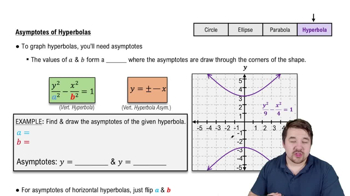What is the domain of sech⁻¹ x? How is sech⁻¹ x defined in terms of the inverse hyperbolic cosine?
Table of contents
- 0. Functions7h 54m
- Introduction to Functions16m
- Piecewise Functions10m
- Properties of Functions9m
- Common Functions1h 8m
- Transformations5m
- Combining Functions27m
- Exponent rules32m
- Exponential Functions28m
- Logarithmic Functions24m
- Properties of Logarithms36m
- Exponential & Logarithmic Equations35m
- Introduction to Trigonometric Functions38m
- Graphs of Trigonometric Functions44m
- Trigonometric Identities47m
- Inverse Trigonometric Functions48m
- 1. Limits and Continuity2h 2m
- 2. Intro to Derivatives1h 33m
- 3. Techniques of Differentiation3h 18m
- 4. Applications of Derivatives2h 38m
- 5. Graphical Applications of Derivatives6h 2m
- 6. Derivatives of Inverse, Exponential, & Logarithmic Functions2h 37m
- 7. Antiderivatives & Indefinite Integrals1h 26m
- 8. Definite Integrals4h 44m
- 9. Graphical Applications of Integrals2h 27m
- 10. Physics Applications of Integrals 3h 16m
- 11. Integrals of Inverse, Exponential, & Logarithmic Functions2h 34m
- 12. Techniques of Integration7h 41m
- 13. Intro to Differential Equations2h 55m
- 14. Sequences & Series5h 36m
- 15. Power Series2h 19m
- 16. Parametric Equations & Polar Coordinates7h 58m
6. Derivatives of Inverse, Exponential, & Logarithmic Functions
Derivatives of Exponential & Logarithmic Functions
Problem 7.3.22
Textbook Question
22–36. Derivatives Find the derivatives of the following functions.
f(x) = sinh 4x
 Verified step by step guidance
Verified step by step guidance1
Step 1: Recall the derivative rule for hyperbolic sine functions. The derivative of sinh(u) with respect to x is cosh(u) * du/dx.
Step 2: Identify the inner function u in the given function f(x) = sinh(4x). Here, u = 4x.
Step 3: Compute the derivative of the inner function u = 4x with respect to x. The derivative of 4x is 4.
Step 4: Apply the chain rule. Substitute u = 4x into the derivative formula: f'(x) = cosh(4x) * 4.
Step 5: Simplify the expression to write the derivative as f'(x) = 4 * cosh(4x).
 Verified video answer for a similar problem:
Verified video answer for a similar problem:This video solution was recommended by our tutors as helpful for the problem above
Video duration:
1mPlay a video:
Was this helpful?
Key Concepts
Here are the essential concepts you must grasp in order to answer the question correctly.
Derivatives
A derivative represents the rate of change of a function with respect to its variable. It is a fundamental concept in calculus that provides information about the slope of the tangent line to the function's graph at any given point. The derivative can be computed using various rules, such as the power rule, product rule, quotient rule, and chain rule.
Recommended video:

Derivatives
Hyperbolic Functions
Hyperbolic functions, such as sinh (hyperbolic sine) and cosh (hyperbolic cosine), are analogs of the trigonometric functions but are based on hyperbolas instead of circles. The function sinh(x) is defined as (e^x - e^(-x))/2. Understanding these functions is crucial for differentiating expressions involving them, as they have specific derivatives that differ from their trigonometric counterparts.
Recommended video:

Asymptotes of Hyperbolas
Chain Rule
The chain rule is a fundamental technique for finding the derivative of composite functions. It states that if a function y = f(g(x)) is composed of two functions, the derivative can be found by multiplying the derivative of the outer function f with the derivative of the inner function g. This rule is particularly useful when differentiating functions like f(x) = sinh(4x), where the inner function is 4x.
Recommended video:

Intro to the Chain Rule

 4:50m
4:50mWatch next
Master Derivatives of General Exponential Functions with a bite sized video explanation from Patrick
Start learningRelated Videos
Related Practice
Textbook Question
43
views
